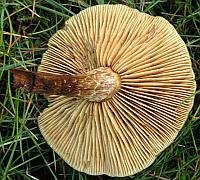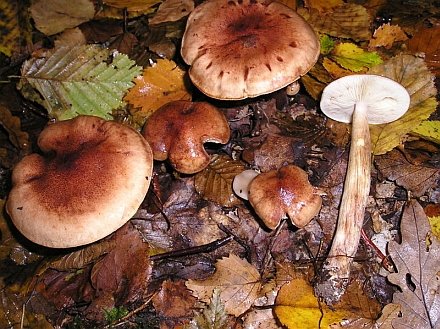The birch knight, Tricholoma fulvum (Bull.) Sacc.
Synonyms
Agaricus flavobrunneus Fr.
Observ. mycol. (Havniae) 2: 119 (1818)
Agaricus fulvus Bull.
Herbier de la France 12: tab. 555, fig. 2 (1792)
Agaricus nictitans Fr.
Syst. mycol. (Lundae) 1: 38 (1821)
Tricholoma flavobrunneum (Fr.) P. Kumm.
Führ. Pilzk. (Zwickau): 130 (1871)
Tricholoma nictitans (Fr.) Gillet
Hyménomycètes (Alençon): 93 (1874)
Common names
Birch knight
Yellowbrown knight cap
Birke-ridderhat (Danish)
Berkenridderzwam (Dutch)
Tricolome brun et jaune (French)
Gelbblätriger Ritterling (German)
Description
Cap: 3-12 cm diameter, convex with umbo and involute to deflexed margin initially, expanding to applanate with or without low umbo, sometimes with undulating marginal zone, with straight margin, red-brown with paler marginal zone, subviscid when moist, becoming distinctly radially fibrillose on drying, finally often breaking up in small, irregular, appressed squamules; marginal zone often having a rough rib-like texture with age.
Gills: crowded, adnate–emarginate, occasionally forked near attachment of stem, narrowly ventricose, pale yellow, often developing reddish brown spots on edges in maturity, with eroded, concolorous edge, particularly near edge when old.

Stem: 4-12 cm tall x 0.5-2 cm thick, cylindrical, sometimes tapering upwards, sometimes flexuous, at very apex white, finely pruinose-flocculose, sometimes rather sharply delimited from lower part; below strongly fibrillose-subsquamulose with red-brown fibrils on paler, yellow or brown background, basal part often tinged clear yellow; becoming hollow with age.
Context: whitish to pale yellow in cap, yellow in stem.
Spore print: white.
Spores: subglobose to oblong with pronounced hilar appendage, smooth, nonamyloid, 5-6.5 x 3.5-5 µm.
Odor: strongly farinaceous when cut.
Taste: farinaceous or slightly bitter.
Edibility: inedible.
Habitat: in small groups, ectomycorrhizal, in association with Betula, in swamp forest and in dry deciduous woods.
Description adapted from Bas et al., (1990), p. 128.
Medicinal properties
Antitumor effects
Polysaccharides extracted from the mycelial culture of T. fulvum (as T. flavobrunneum) and administered intraperitoneally into white mice at a dosage of 300 mg/kg inhibited the growth of Sarcoma 180 and Ehrlich solid cancers by 80% and 70%, respectively (Ohtsuka et al., 1973).

My name is Austin Collins.
I've dedicated my life to Mushrooms.
I believe Mushrooms are the best kept secret when it comes to health and well being.
For that reason, I would like to share a company with you that in my opinion makes the best mushroom products on the market.
The company is called Noomadic Herbals, my favorite supplement they make is called "Mushroom Total".
I take their products every day and they have helped me think better and have more energy. Give them a try.
-Austin
Links
- Fungi of Poland has photos and descriptions
References
Bas C, Kuyper TW, Noordeloos ME, Vellinga EC. (1990).
Flora Agaricina Neerlandica: Critical Monographs on Families of Agarics and Boleti Occurring in the Netherlands.
Balkema, Rotterdam, Brookfield. 137 pp.
Ohtsuka S, Ueno S, Yoshikumi C, Hirose F, Ohmura Y, Wada T, Fujii T, Takahashi E.
Polysaccharides having an anticarcinogenic effect and a method of producing them from species of Basidiomycetes.
UK Patent 1331513, 26 September 1973.


